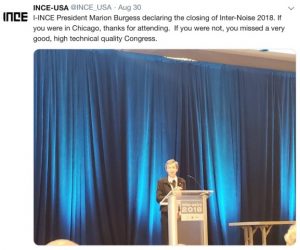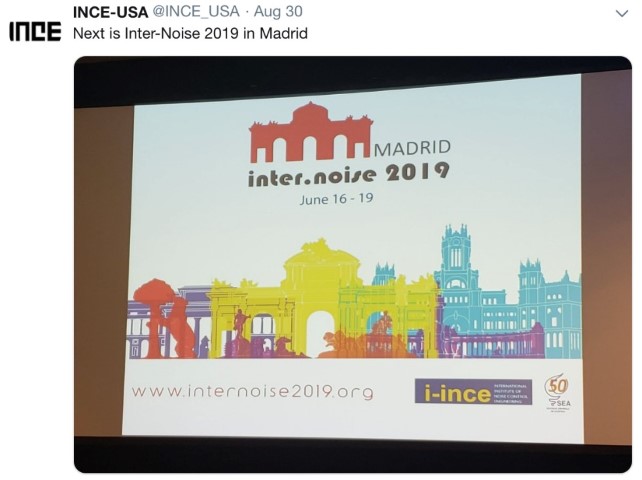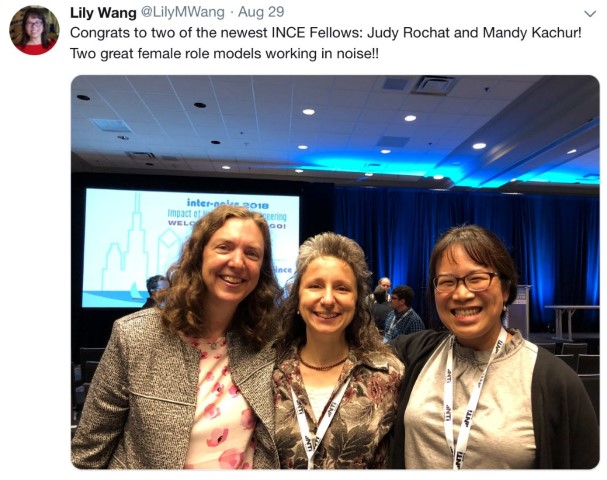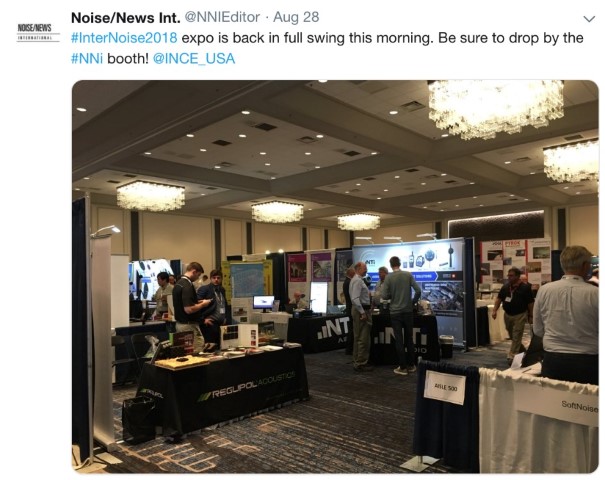INTER-NOISE 2018 Report
INTER-NOISE 2018, the 47th International Congress and Exposition on Noise Control Engineering, was held August 26–29, 2018, at the Marriott Magnificent Mile, Downtown Chicago, Illinois, USA. The conference saw 621 oral technical presentations, 65 poster presentations, 9 classic paper presentations, 4 keynote lectures, and 2 plenaries. INTER-NOISE 2018 was organized by Charlie Moritz (congress president), Joe Cuschieri (congress copresident), David Herrin (technical program cochair), and Teik Lim (technical program cochair). Also assisting with the organization and administration of the conference were Cathy Vail (congress secretariat), Richard J. Peppin (exhibition manager), Dana Lodico (student volunteer coordinator), and Gordon Ebbit and Sarah McGuire (proceedings editors).
This year the theme of the conference was “impact of noise control engineering,” and contributions came from all around the world. There were a total of 952 registrants in attendance, including 194 students. With 79 technical sessions and 6 poster sessions housed in the conference center, the congress was very well organized and quite successful.
The congress was sponsored by I-INCE and was organized by INCE-USA. The conference also saw participation and organization from the American Society of Mechanical Engineers (ASME) Noise Control Acoustics Division (NCAD). NCAD routinely participates in ASME’s International Mechanical Engineering Conference and Exhibit (IMECE), but every three years the annual conference for NCAD is held in conjunction with INCE-USA, which occurred this year at INTER-NOISE 2018.
Opening the Conference—Sunday, August 26
The opening events for the conference were held on Sunday afternoon, August 26. In the opening ceremony, the organizers provided a very nice opening reception with a warm welcome to attendees from around the world.
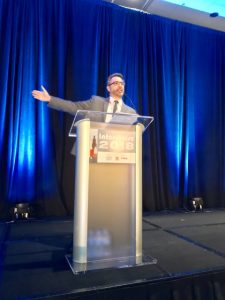
Figure 1. Charlie Moritz welcomes everyone to INTER-NOISE 2018.
The first keynote presentation was by Barry Gibbs, a professorial fellow within the Acoustics Research Unit of the University of Liverpool School of Architecture. The topic of his talk was “Structure-Borne Sound in Buildings: Application of Vibro-Acoustic Methods to Measurement and Prediction.” He noted that the methods required for prediction of structure-borne sound are more complicated than for airborne sound, but practitioners of building acoustics require methods for the former, which are as straightforward as for the latter. His work proposes a database, based on reception plate measurements and on simple calculations, which offers consultants and design engineers a practical approach to predicting structure-borne sound.
Sunday also saw a free STEM workshop that was open to the public. It was hosted by A Quieter Future (AQF) and INCE-USA. The workshop had free STEM kits and curriculum (adaptable for K–8) available. Through hands-on activities and engaging speakers, participants learned about the physics of sound, the importance of sound in marine and terrestrial ecosystems, and the effects of pollution on the environment.
Monday, August 27
The technical program began on Monday, August 27. There were 14 parallel sessions covering a wide array of topics.
There were two parallel keynote lectures to begin the day. Jean-Louis Guyader, emeritus professor at the National Institute of Applied Sciences (INSA) in Lyon, France, gave a talk titled “Building Non Modal Vibro-Acoustics Models from Measured System Responses.” This lecture considered the problem of determining the optimal model to describe the vibration of a structure. He proposed a model based on a set of candidate models whose parameters are set by fitting theoretical dispersion curves to experimental ones. In particular, his work considered the Akaike Information Criterion to select the optimal model.
In parallel, Dr. A. R. Mohanty, professor of mechanical engineering at the Indian Institute of Technology, Kharagpur, India, and also the Shyamal Ghosh and Sunanda Ghosh chair professor, gave a lecture titled “Acoustic Materials for Industrial Noise Control.” This work studied the effect of pretreatment procedures on the acoustic, thermal, and physical properties of jute-based composites. It found that jute fibers and jute composites have high transmission loss, high sound absorption coefficients, low flammability, low density, and high thermal stability; thus, they are an excellent choice for industrial noise control.
The encouragement of young professionals is vitally important, and in recognition of this, I-INCE funds a number of young scientist grants to assist with participation at each Congress. On Monday afternoon, the I-INCE Young Professional Workshop was held. This followed a practice school for young professionals already held on Sunday. At the practice school, four case studies on successful applications of noise control were presented. The goals of the young professional practice school are to provide mentorship via case studies and professional issues presented by world-renowned experts and to hold informal discussions between young professionals and I-INCE leaders and senior noise control engineers. Following the school, all participants were invited to the young professional workshop to gain valuable contacts and view presentations by noise control professionals.
Monday also saw an NCAD Tutorial and the NCAD General Meeting. The Rayleigh Lecture award lecture was also scheduled for this day. This year the awardee was Professor Roger Ohayon for his work with computational vibroacoustics in low- and medium-frequency bands. The Rayleigh Lecture award is given to an individual who has made pioneering contributions to the sciences as well as applications to industry.
The day concluded with the Exposition Opening Reception, held from 5:30 p.m. to 7:30 p.m. There were 81 different exhibitors, spanning interests from instrumentation to building materials, and including participation from us here at NNI.
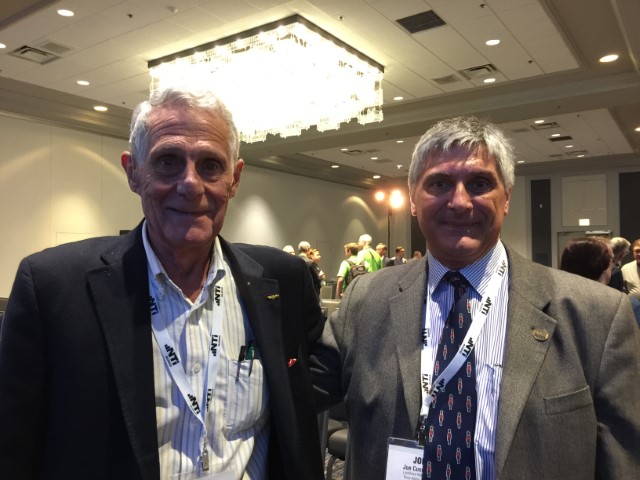
Figure 2. Eric Wood and Joe Cuschieri at INTER-NOISE 2018. At the congress, Eric Wood received the INCE Distinguished Service Award to recognize his long history of service to the institute.
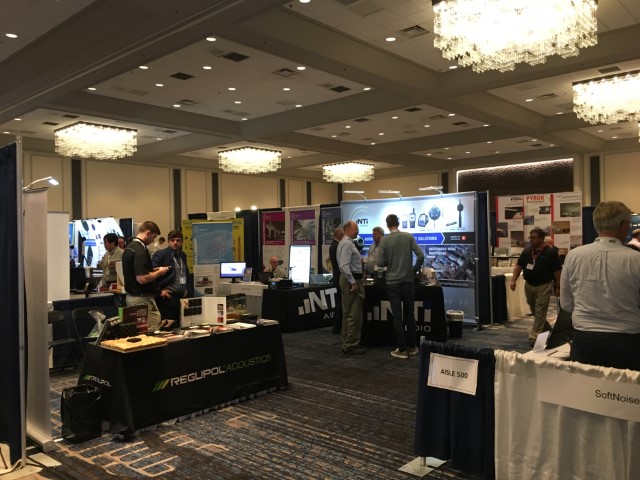
Figure 3. The INTER-NOISE 2018 Exposition.
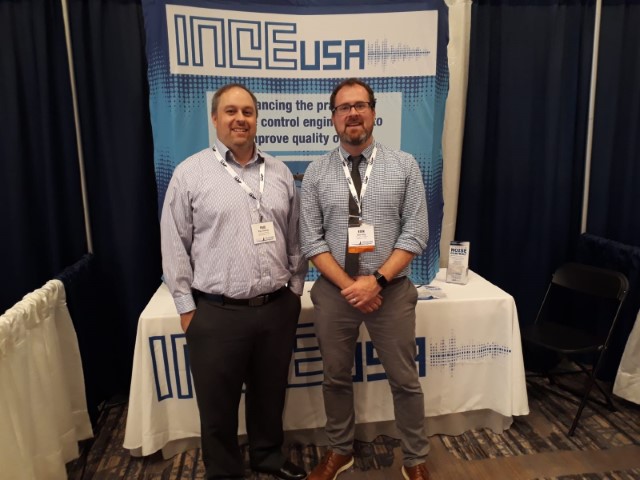
Figure 4. The NNI booth at the INTER-NOISE 2018 Expo.
Tuesday, August 29
On Tuesday there were 14 parallel technical sessions in operation covering a wide range of topics. Both the technical sessions and the exhibition continued through this day. There was active participation in both with many excellent papers.
There were two more keynote talks on Tuesday morning. Truls Gjestlan, a fellow of the Acoustical Society of America, delivered a talk titled “Fifty Years of Aircraft Noise Annoyance—Time to Introduce New Ideas.” This talk was based on his experience as a research scientist at SINTEF for 50 years. His lecture pointed out that the conventional search for a “holy grail” of annoyance prediction is futile. Instead he offered a modern, causal approach to creating dose-response relationships for aircraft noise annoyance, which systematically treats nonacoustic factors and quantifies their influence.
In parallel, Dr. Li Cheng, chair professor of mechanical engineering and the director of Consortium for Sound and Vibration Research (CSVR) at the Hong Kong Polytechnic University, gave his keynote titled “Sound Absorption of Micro-Perforate Panels in Complex Vibroacoustic Environments.” This work considered the in situ sound absorption behavior of microperforate panels in various vibroacoustic environments, the modeling of their coupling with the surrounding acoustic medium, the underlying sound absorption physics as well as the influence of grazing flows.
Tuesday also saw the Women in Noise Control Engineering Lunch, the William Lang Memorial Session, and the Congress Banquet, which was held at the Museum of Science and Industry.
Wednesday, August 30
Technical sessions continued until 3:00 p.m. on Wednesday. The day also saw the INCE-USA Award Ceremony held in the afternoon. There were three major awards announced. Michael Bahtiarian received the William W. Lang Award for Distinguished Noise Control Engineer, Noral Stewart received the 2018 Laymon N. Miller Excellence in Acoustical Consulting Award, and the Martin Hirschorn IAC Award Best Paper Prize was announced as Hugo E. Camargo, Amanda S. Azman, and Lynn Alcorn’s “Development of Noise Controls for Longwall Shearer Cutting Drums,” published in NCEJ in 2016 (see vol. 64, no. 5:573–85).
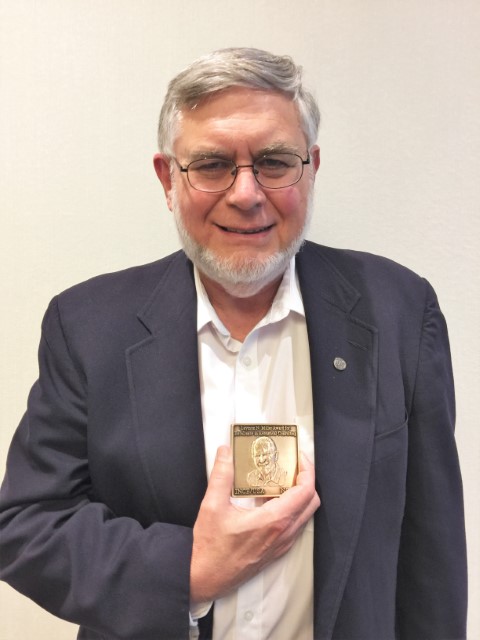
Figure 5. Noral Stewart—the 2018 Laymon N. Miller Excellence in Acoustical Consulting Awardee.
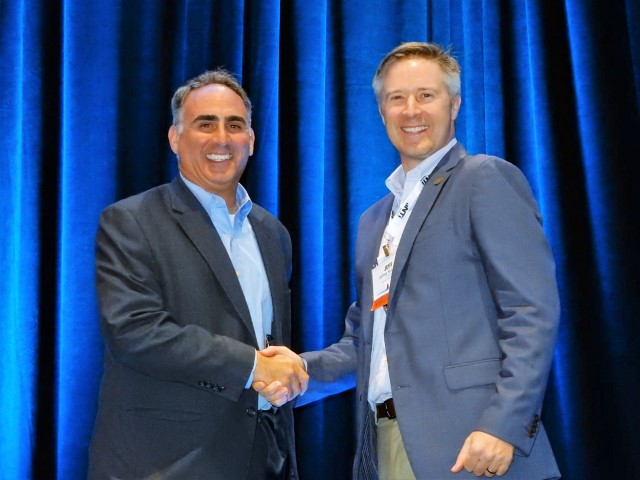
Figure 6. Michael Bahtiarian (left)—the 2018 William W. Lang Awardee for Distinguished Noise Control Engineer.
The final plenary lecture was by Patricia Davies from Ray W. Herrick Laboratories, Purdue University, and was titled “Perception-Based Engineering: Integrating Sound Perception into Engineering Design.” This lecture reported that the integration of sound perception into engineering design requires an understanding of the models of noise generation, propagation, sound perception, and sound evaluation. Prof. Davies noted that such acoustical modeling need to be complemented by models of nonacoustic aspects of the design, and the parts of the multidisciplinary design and product realization team should collaborate throughout the process to find creative ways to satisfy the various needs of the user of the product.
The closing ceremony was held on Wednesday evening. I-INCE President Marion Burgess declared the closing of INTER-NOISE 2018, and the ceremony concluded with an invitation to Madrid for INTER-NOISE 2019.
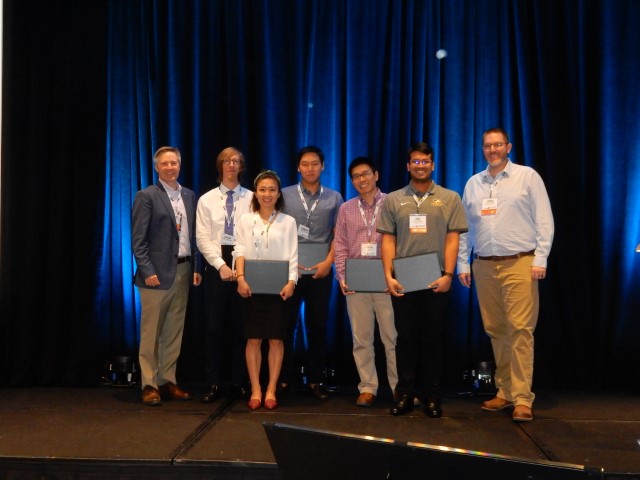
Figure 7. Student Award Ceremony—I-INCE recognizes the encouragement of young professionals is vitally important.
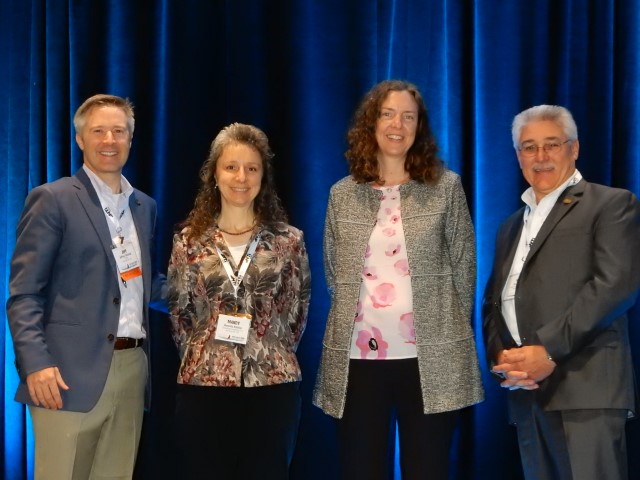
Figure 8. Jeff Fullerton (left) introducing the new INCE-USA fellows (left to right): Mandy Kachur, Judy Rochat, and Rick Kolano.
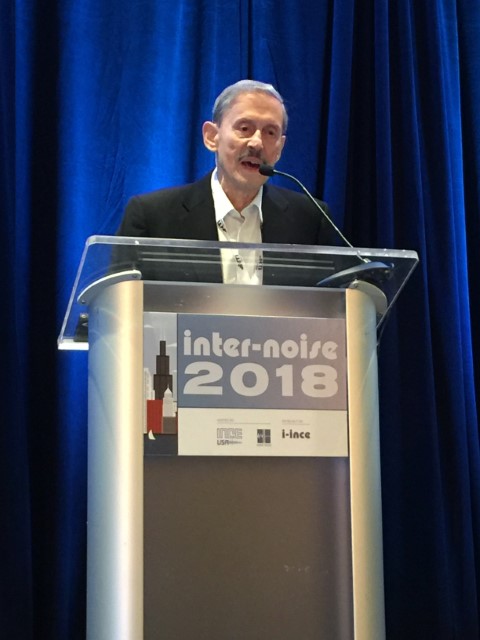
Figure 9. Jack Mowry, who received special recognition from INCE-USA for his contributions to the noise control community as editor and publisher of Sound and Vibration.
Social Media Round-Up: #INTERNOISE2018
